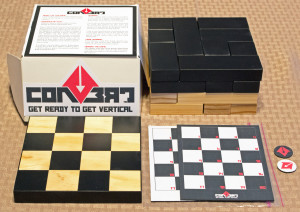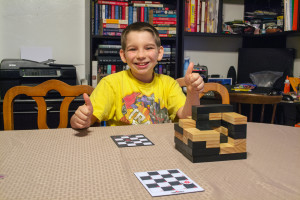Go on, admit it…you played with blocks as a kid. There’s no sense in denying it. We, as educated and mature adults (ha!), often refine our tastes as we get older…yet there are occasions where the simplest things can grant us the most enjoyment. “Convert” is one such item, tasking players with stacking blocks in such a way that would earn them the most points. It’s a very simple, yet elegant abstract game for two players that you won’t want to play just once. Before we get started, I’d like to thank Ian Reed from Yodeo Games for providing me with a free press copy. It’s important to note that the copy I received was a prototype, meaning that it may look a bit different from those created during production. The box and the scorecards, for example, will look much better in the final version than in the pictures below. Because my copy was close enough in quality to the final product however, I opted to do a full review.
Components
Board – The game board consists of a 4×4 grid of alternating tan and white squares, sort of like a miniature “Chess” or “Checkers” board.
Pieces – There are two sets of ten pieces, one for each player color. Both sets are identical to one another, though the piece configurations in a particular set varies.
Scorecards & Markers – There are two scorecards, one for each player, that track a particular player’s score throughout the game. Players will be earning points both during the game and at the game’s end.
Setup & Gameplay
Each player receives a set of ten pieces and the board is placed between them. Unlike “Chess”, it doesn’t matter which corner has the tan square.
On a player’s turn, they’ll select a piece from their pool and place it on the board. The only placement rule that players will need to observe is that they can’t have any empty spaces underneath a piece after placing it. “Tetris Link” has a similar rule, though that game simply penalizes players points for breaking it. For obvious design reasons, pieces can’t be placed on their sides.
At the end of a player’s turn, they’ll check to see if they scored. They earn one point for every row of their color that they created on that turn. Rows can be made up of blocks on any horizontal level, including those squares featured on the board’s original base. Players do not earn points when they place a block on top of a row that they’ve already scored on in a previous round…though if their opponent placed blocks on top of that row at some point, then they’ll be able to score again since the configuration has changed.
Players continue placing blocks, attempting to cover the blocks of the opposite color (called converting, hence the name) while forming complete rows of their own to score points. When a player cannot legally place a piece, their turn is skipped. When both players cannot legally place a piece, the game ends. At this point, players look at the board from a top-down view and count the number of blocks of their color, similar to what you’d do at the end of an “Othello” match. Players add these values to the points they’ve earned throughout the game and whoever has the most, wins.
For a visual recap of the rules, please check out the below developer video:
The Review
One of the features that stood out to me immediately was the size of the blocks. Playing “Jenga” and other similar games can be difficult for some people, since they require a fair amount of dexterity and eye-hand coordination. I’m pleased to report that the playing pieces in “Convert” were nice and big, which did well to prevent accidental bumps from toppling the game and resulting in a huge mess. In terms of quality, the pieces are well crafted and solid. As I stated above, the box included in my copy wasn’t final, so I can’t comment on how well it’ll function post production. Considering that there aren’t that many components in the game, I can’t fathom why there’s be any problems containing all of the pieces appropriately. The one-page card I received did a good job in explaining the rules, though I found the video to be a bit more helpful just because of the three-dimensional element involved.
The game itself is incredibly easy to learn, but there was a lot to consider before making a particular move. I found myself taking minutes at a time to formulate my next move, much like I sometimes do in games like “Blokus”. After a few games, I’ve concluded that there is a heavy emphasis on strategy with little to no reliance on luck. Players will need to think ahead and adapt to the situation as it develops. The perfectionist in me had a hard time accepting that the pieces I put down would eventually get converted. For example, I often maneuvered my pieces in “Othello” to grab corners and the edges to prevent them from being flipped. In “Convert”, the question isn’t “if” your pieces will be converted, it’s “when”. As pieces begin running out in each of the player pools however, you’ll start to run into instances where the pieces you put down might stand a chance in staying on the top-most level.
Vinnie (12) is too young to remember when “Tetris” first appeared on the “GameBoy”, but he quickly adapted and gave a valiant effort in trying to get his pieces to lock themselves in a way that would benefit him most. As someone who grew up with puzzle games like “Tetris”, I had a bit of an edge. Regardless of my age and advantage, the games we played were very close from start to finish. The design of the pieces were simple yet varied enough to where Vinnie was able to make the most out of a situation regardless of how well I tried to trip him up. As we approached the endgame, I noticed that his pauses became a lot more frequent before he placed a piece. I found myself doing the same, mainly due to the fact that we were both becoming more and more limited in terms of the moves we could make. At the end of it all, he expressed an interest in playing again at a later date and I, in my infinite wisdom, wasn’t about to say no.
There is one thing that bothers me about the game and I’ve been at ends trying to look at both sides of the issue. The estimated (note the word “estimated”) retail price of the game is going to clock in around $29.99, which to me, seems a bit high. Games like “Stone Age” and “Power Grid” can be bought for roughly the same price, and they contain almost ten times the amount of quality components. One of the reasons that I haven’t purchased “Blokus 3D” yet was because of its price tag. On the other side of the coin, “Blokus 3D” and “Quadefy” both sell for a little over thirty bucks. I really can’t fault the developer for staying with the trend in order to stay competitive, I just find it a shame that educational games like these are so expensive. I have zero experience developing a game and my knowledge on the manufacturing process is equally lacking, so it’s possible that it really costs that much to produce games like this. When you look at it through the eyes of paying customers who have no experience in the gaming industry however, it’s easier to see why they might not understand or agree with the retail price when they pass it by on the shelf. In the end, it comes down to what the individual is comfortable paying and will therefore have to make that determination for themselves.
When it comes down to it, “Convert” is an excellent example of critical thinking at its finest. This game will challenge you to think ahead and rewards those who do. Despite your best intentions, the general flow of the game is going to be a chaotic one. To that end, “Convert” will truly test how well you can adapt to an ever-changing environment. It’s an excellent game for players of all ages and in my opinion, highly educational. I’ve recommended games like “Chess”, “Khet”, and “Blokus” for the way they make you think outside of the box, and I’m glad to have been able to add “Convert” to that list. It’s simple, yet not…the hallmark of a true and compelling strategy game. Whether you are a strategy enthusiast or just a parent like myself looking for another game to introduce on family night, “Convert” is a no-brainer (pardon the pun). If the retail price is too much for you, I’d recommend keeping an eye out for used copies on Amazon or eBay down the line…you might get lucky! In the meantime, feel free to help support it on Kickstarter via the links below.
Final Verdict: 9/10
—
You can learn more about and support the game via the links below:
http://www.kickstarter.com/projects/727108637/convert
http://boardgamegeek.com/boardgame/140236/convert
—


